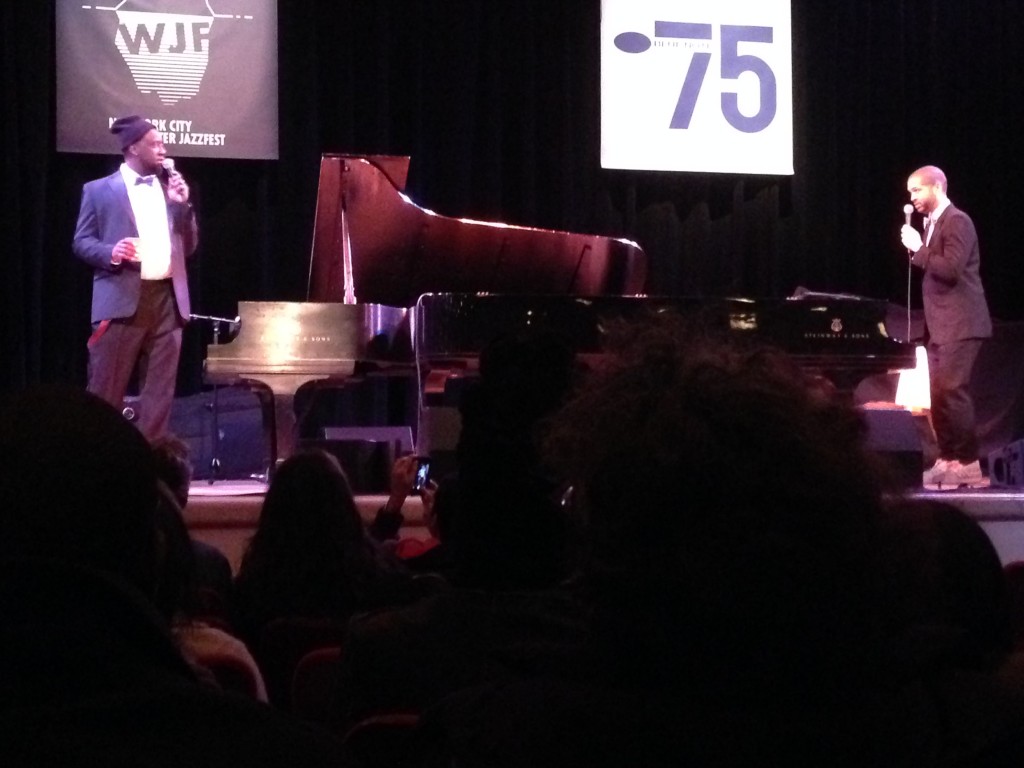January 7-11, 2014 marked the 10th Anniversary of the Winter Jazzfest in New York City. The growth of the festival has seemed almost exponential since its inception in 2004, when it presented 19 groups on one night; this year’s event began on Tuesday evening and continued each night until early Sunday morning, showcasing over 90 groups in total. Although the marquee events on Tuesday, Wednesday, and Thursday nights were highlights, the centerpiece of the festival was the two-night marathon in the Village, presented at venues ranging from the sizable music and art space at Le Poisson Rouge to the narrow confines of Groove (or, as Craig Handy jokingly dubbed it during a rowdy call-and-response with the audience on Saturday night, “The Groove Lounge”).
—
Pace Bobby Previte’s Terminals, I began the festival with the Blue Note Records 75th Anniversary concert at The Town Hall on Wednesday, January 8. In recognition of the record label’s inaugural recording session featuring Meade Lux Lewis and Albert Ammons, present-day luminaries Robert Glasper and Jason Moran opened the performance with a couple of boogie woogie classics. Each pianist showcased a unique style; Mr. Glasper favored tone clusters, lyrical melodies, and an adventurous sense of rhythm and time, while Mr. Moran built lively, angular phrases with complex polyrhythms and a razor-sharp attack. The first half of the concert also featured a “battle” of sorts, as Mr. Glasper and Mr. Moran took turns interrupting one another, often with a recognizable riff or melody (some of which, as Harmonious Assembler over at Revive Music pointed out, may be best known to some as hip-hop samples), a moving tribute to their mothers that featured each musician taking a turn at the Rhodes, and “Retrograde,” a composition from Mr. Moran’s Blue Note debut Soundtrack to Human Motion. In between pieces and even in the middle of a few, the pianists joked both with the audience and with one another. Their presence was engaging and infectious: serious musicianship with a not-quite-so-serious manner; professionalism without pretentiousness.
The second half of the concert brought Ravi Coltrane (ts) along with the pianists’ fellow HSPVA alums Alan Hampton (b) and Eric Harland (d) into the mix. The all-star group hit first with a take on “Toy Dance” from Ornette Coleman’s underrated 1968 Blue Note sessions. They were then joined on stage by Bilal, a vocalist who, while not quite attaining the mainstream popularity of some of his “neo-soul” [sic] contemporaries, has recently distinguished himself as an adventurous and wide-ranging singer, both as a leader and in collaborations, including several with Mr. Glasper. The all-star group worked through three more tunes: the jazz standard “Body and Soul” (an arrangement that Bilal and Mr. Moran worked out on a gig in Brooklyn several years ago), Thelonious Monk’s “Criss-Cross,” and “All Matter” off of Mr. Glasper’s Double-Booked. Bilal’s soaring vocal on the latter was a standout moment, although I do wish there had been more space for Mr. Coltrane throughout the second half of the concert. The group closed out the night with another of Mr. Glasper’s tunes, this one from Canvas, his own Blue Note debut and a fitting conclusion to the concert.
The buzz in the building that night was palpable, and it reverberated like feedback as the concert unfolded. My sense was that many of the attendees had designs to attend more of the Winter Jazzfest events, but maybe more had come to this concert as a one-off. The promotional material had drawn specific attention to the legacy of Blue Note and the Lewis/Ammons session in particular, and I wondered before the concert if any of the audience members had come expecting a showcase of boogie woogie and other period styles or perhaps even a retrospective of some iconic Blue Note recordings from its 75-year history. I wondered whether such folks would trust this titanic legacy to the hands of these expert yet still relatively young musicians (at 48, Ravi Coltrane was the elder statesman of the group). And I wondered how they were digesting the music, which looked more forward than back, as the musicians tipped their hats to the ancestors but celebrated their own eminently contemporary sounds and styles. But my sense, as I left the auditorium, was that most people, like me, were simply rejuvenated. Perhaps more than anything, this concert honored the spirit of Blue Note Records, especially its legacy of bonding together the vibrancy and power of live music, the accessibility and intimacy of recorded music, and the iconography and style of jazz’s most engaging figures and forms.
This is the first in a series of posts.



